Modulation Code for Reducing Intertrack Interference on Staggered Bit-Patterned Media Recording
Abstract
:1. Introduction
2. Staggered BPMR Channel Model and PRML Detection
2.1. Staggered BPMR Channel Model
2.2. PRML Detection
3. Proposed 7/10 Modulation Code for Mitigating ITI
3.1. Encoding Scheme
3.2. Decoding Scheme
4. Simulation and Results
5. Conclusions
Author Contributions
Funding
Conflicts of Interest
References
- Richter, H.J.; Dobin, A.Y.; Heinonen, O.; Gao, K.Z.; Veerdonk, R.J.V.D.; Lynch, R.T.; Xue, J.; Weller, D.; Asselin, P.; Erden, M.F.; et al. Recording on bit-patterned media at densities of 1 Tb/in2 and beyond. IEEE Trans. Magn. 2006, 42, 2255–2260. [Google Scholar] [CrossRef]
- Zhu, J.; Lin, Z.; Guan, L.; Messner, W. Recording, noise, and servo characteristics of patterned thin film media. IEEE Trans. Magn. 2000, 36, 23–29. [Google Scholar]
- Chang, W.; Cruz, J.R. Inter-track interference mitigation for bit-patterned magnetic recording. IEEE Trans. Magn. 2010, 46, 3899–3908. [Google Scholar] [CrossRef]
- Wood, R.; Williams, M.; Kavcic, A.; Miles, J. The feasibility of magnetic recording at 10 terabits per square inch on conventional media. IEEE Trans. Magn. 2009, 45, 917–923. [Google Scholar] [CrossRef]
- Nutter, P.W.; Ntokas, I.T.; Middleton, B.K.; Wilton, D.T. Effect of island distribution on error rate performance in patterned media. IEEE Trans. Magn. 2005, 41, 3214–3216. [Google Scholar] [CrossRef]
- Ng, Y.; Cai, K.; Kumar, B.V.K.V.; Chong, T.C.; Zhang, S.; Chen, B.J. Channel modeling and equalizer design for staggered islands bit-patterned media recording. IEEE Trans. Magn. 2012, 48, 1976–1983. [Google Scholar] [CrossRef]
- Wu, Z. Coding and Iterative Detection for Magnetic Recording Channels, 1st ed.; Kluwer Academic: Norwell, MA, USA, 2000; pp. 11–12. [Google Scholar]
- Keskinoz, M. Two-dimensional equalization/detection for patterned media storage. IEEE Trans. Magn. 2008, 44, 533–539. [Google Scholar] [CrossRef]
- Yang, S.; Han, Y.; Wu, X.; Wood, R.; Galbraith, R. A soft decodable concatenated LDPC code. IEEE Trans. Magn. 2015, 51, 9401704. [Google Scholar] [CrossRef]
- Jeong, S.; Lee, J. Iterative LDPC–LDPC product code for bit patterned media. IEEE Trans. Magn. 2017, 53, 3100704. [Google Scholar] [CrossRef]
- Nguyen, T.A.; Lee, J. Error-Correcting 5/6 Modulation Code for staggered bit-patterned media recording systems. IEEE Magn. Lett. 2019, 10, 6510005. [Google Scholar] [CrossRef]
- Nguyen, C.D.; Lee, J. Elimination of two-dimensional intersymbol interference through the use of a 9/12 two-dimensional modulation code. IET Commun. 2016, 10, 1730–1735. [Google Scholar] [CrossRef]
- Nabavi, S.; Kumar, B.V.K.V.; Bain, J.A. Two-dimensional pulse response and media noise modeling for bit-patterned media. IEEE Trans. Magn. 2008, 44, 3789–3792. [Google Scholar] [CrossRef]
- Nabavi, S.; Kumar, B.V.K.V.; Bain, J.A.; Hogg, C.; Majetich, S.A. Application of image processing to characterize patterning noise in self-assembled nano-masks for bit-patterned media. IEEE Trans. Magn. 2009, 45, 3523–3526. [Google Scholar] [CrossRef]
- Kim, J.; Wee, J.; Lee, J. Error Correcting 4/6 Modulation Codes for Holographic Data Storage. Jpn. J. Appl. Phys. 2010, 49, 08KB04. [Google Scholar] [CrossRef]
- Nguyen, C.D.; Lee, J. 8/10 two-dimensional modulation code for holographic data storage systems. Electron. Lett. 2016, 52, 710–712. [Google Scholar] [CrossRef]

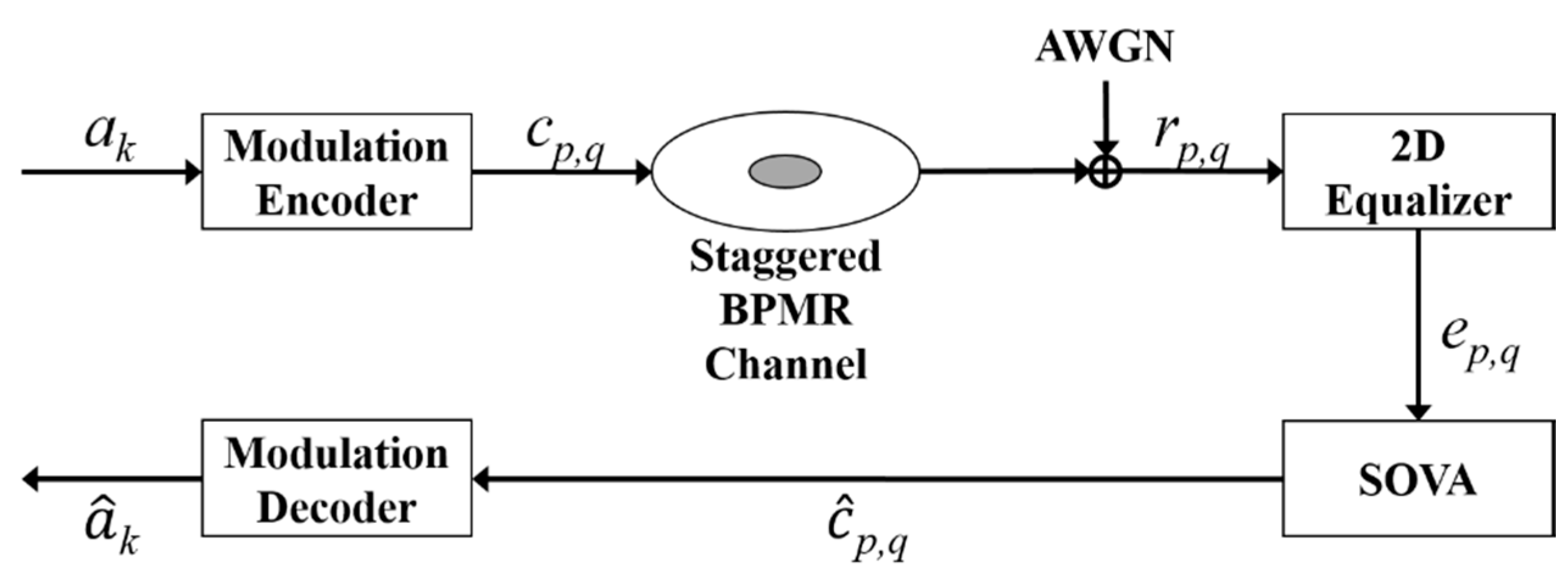
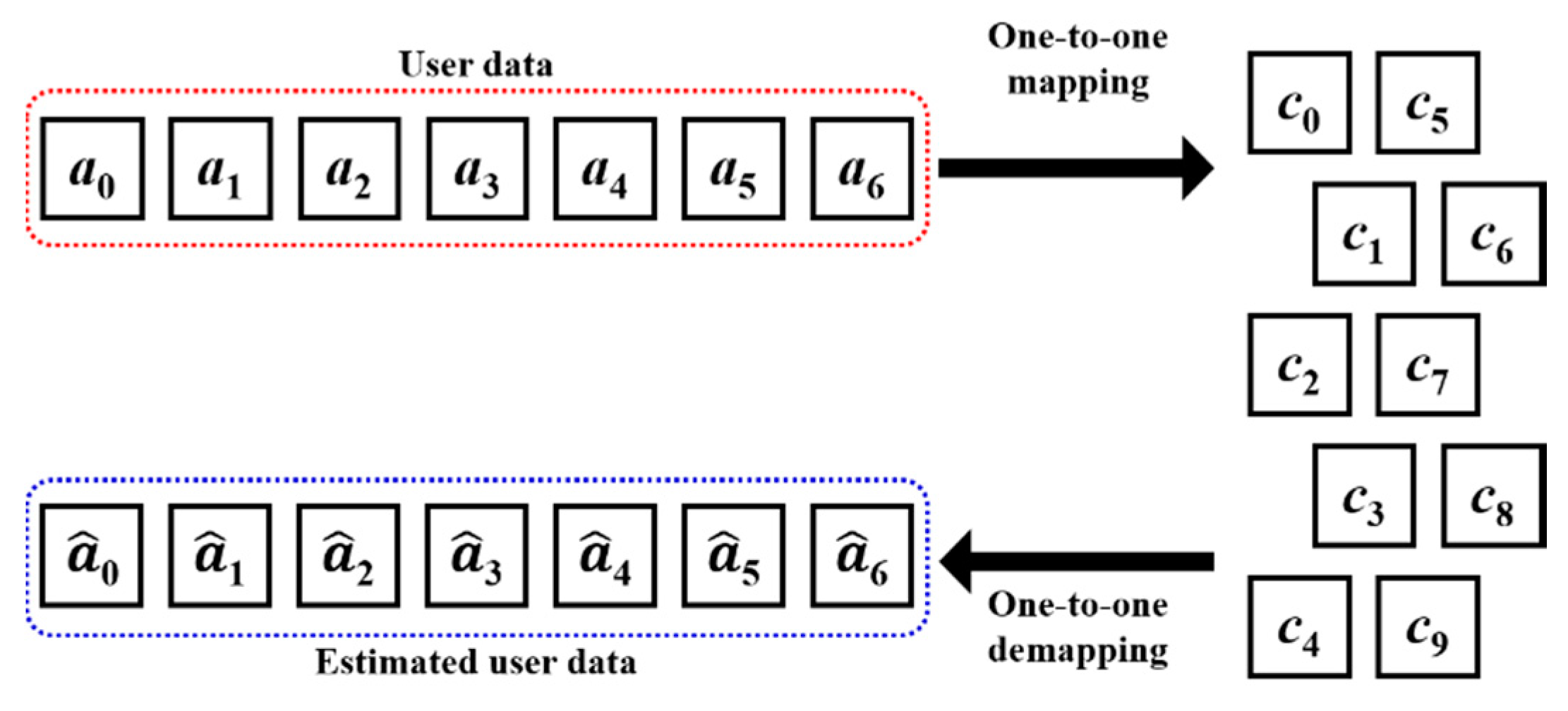

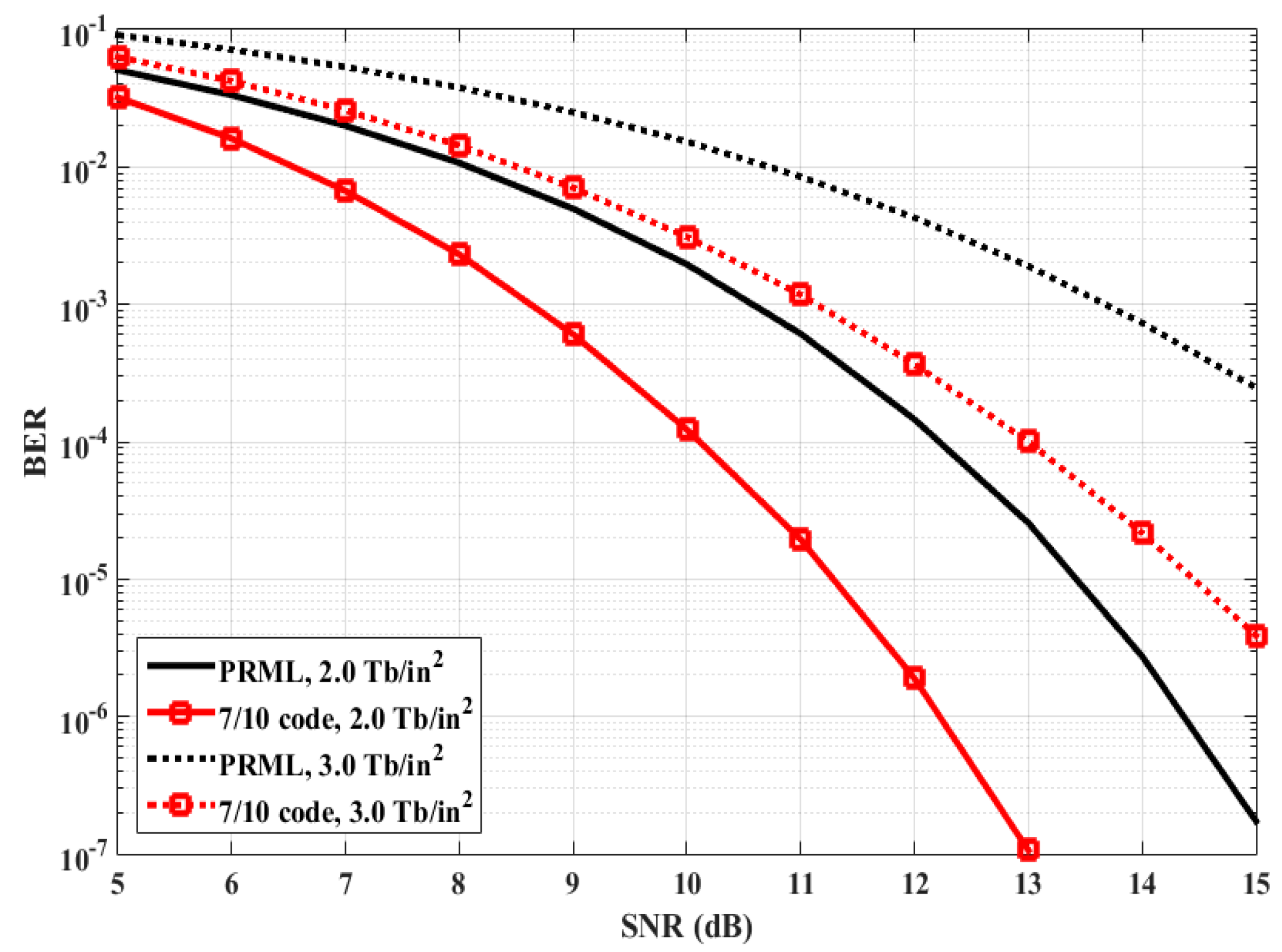
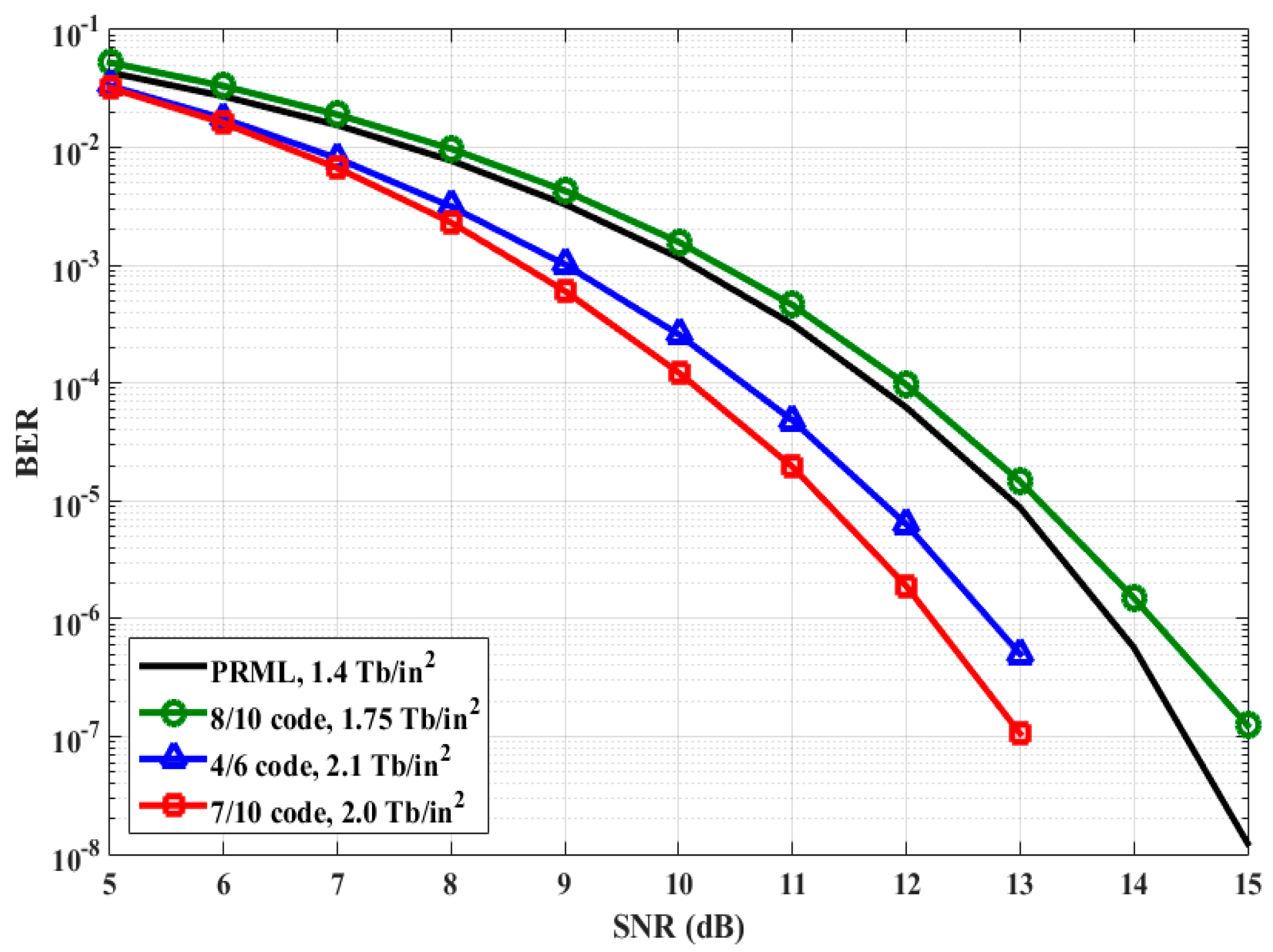
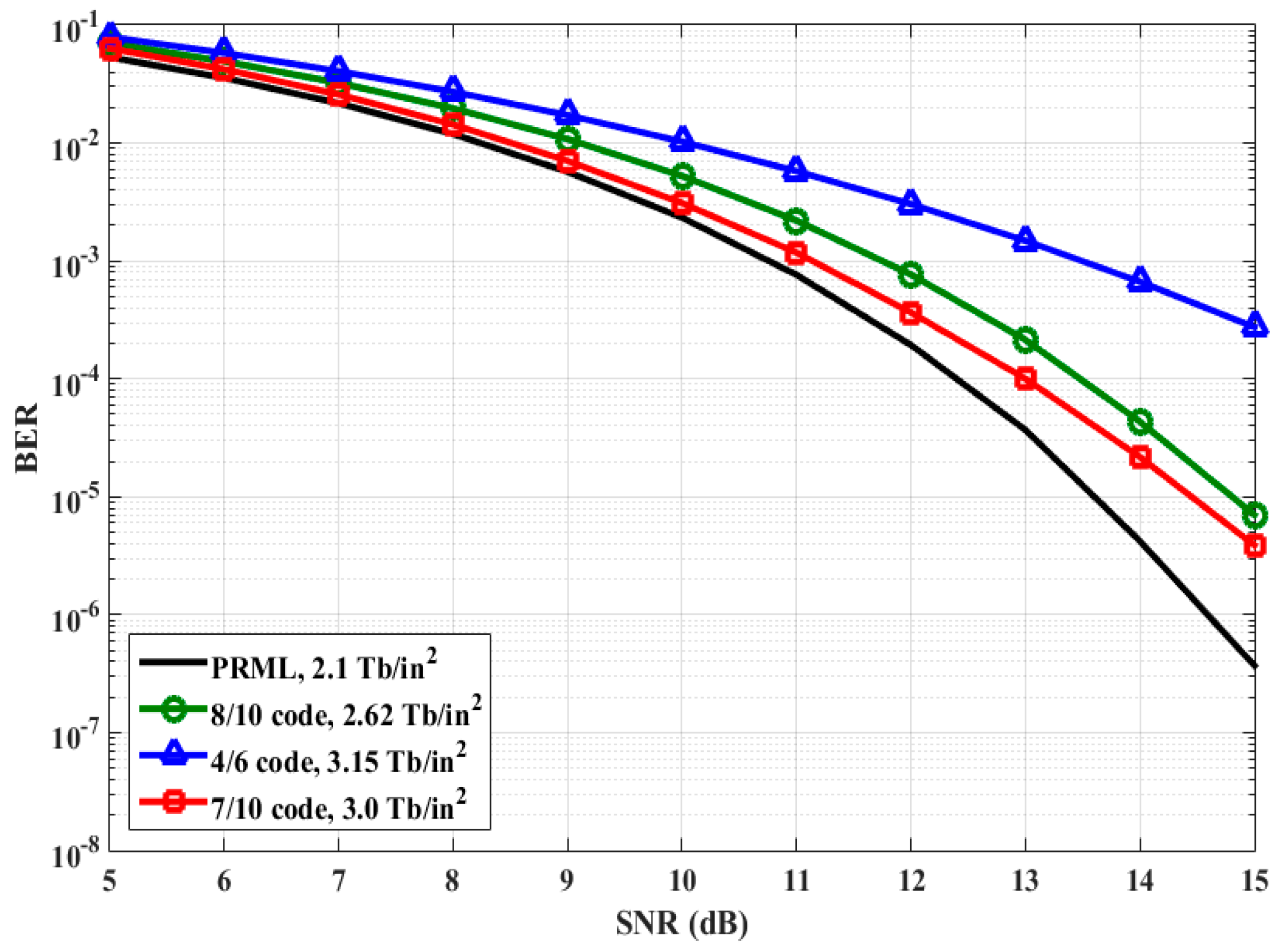
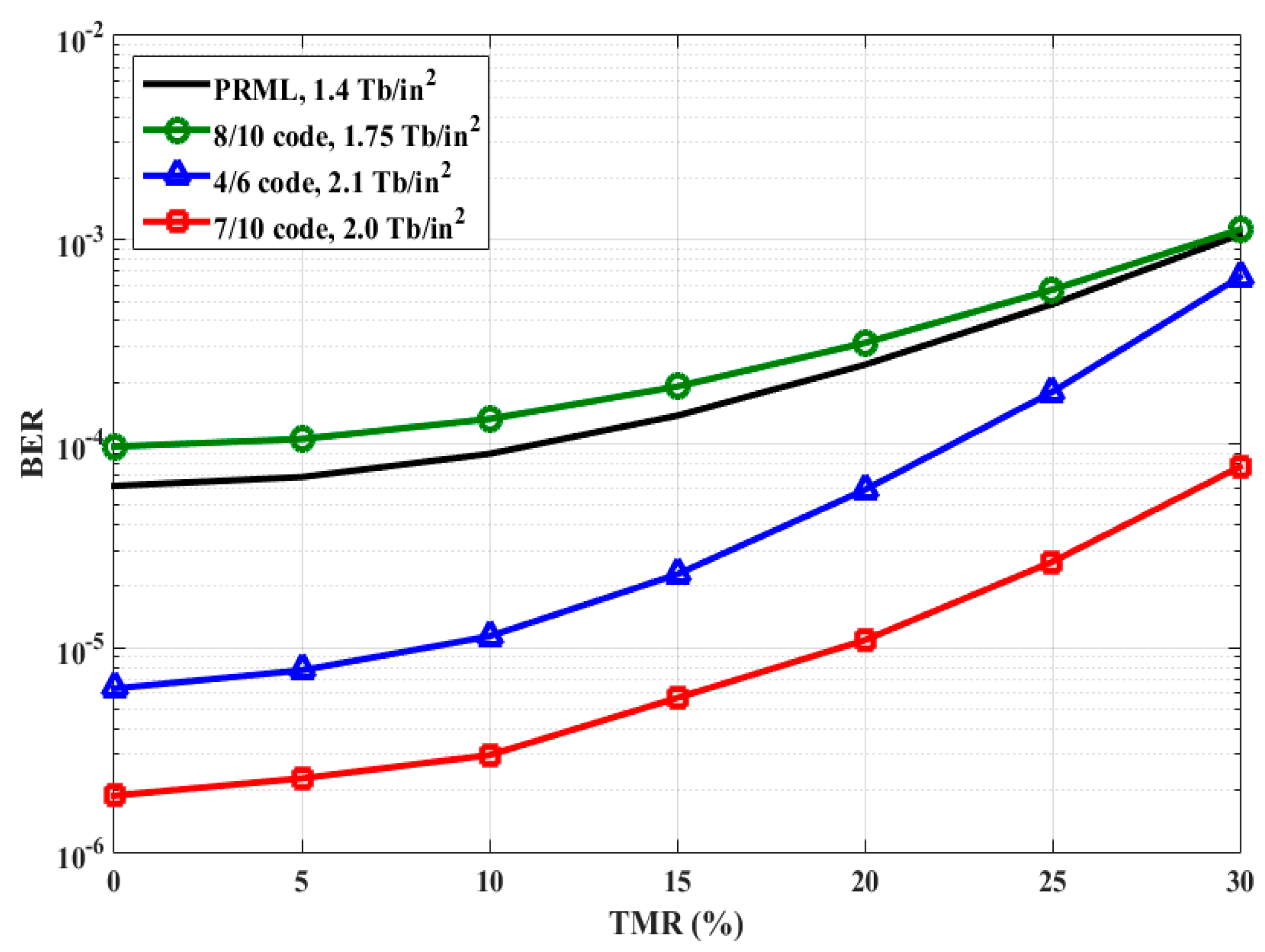
| Input Sequence | Codeword | Input Sequence | Codeword | Input Sequence | Codeword | Input Sequence | Codeword |
|---|---|---|---|---|---|---|---|
| 0000000 | 0000000000 | 0100000 | 0011100001 | 1000000 | 1000000001 | 1100000 | 1100100001 |
| 0000001 | 0000000011 | 0100001 | 0011100111 | 1000001 | 1000000111 | 1100001 | 1100100111 |
| 0000010 | 0000000110 | 0100010 | 0011101110 | 1000010 | 1000001110 | 1100010 | 1100101110 |
| 0000011 | 0000001100 | 0100011 | 0011110000 | 1000011 | 1000010000 | 1100011 | 1100110000 |
| 0000100 | 0000001111 | 0100100 | 0011110011 | 1000100 | 1000010011 | 1100100 | 1100110011 |
| 0000101 | 0000010001 | 0100101 | 0011111001 | 1000101 | 1000011001 | 1100101 | 1100111001 |
| 0000110 | 0000011000 | 0100110 | 0011111100 | 1000110 | 1000011100 | 1100110 | 1100111100 |
| 0000111 | 0000011110 | 0100111 | 0011111111 | 1000111 | 1000011111 | 1100111 | 1100111111 |
| 0001000 | 0000100001 | 0101000 | 0110000000 | 1001000 | 1000100000 | 1101000 | 1110000001 |
| 0001001 | 0000100111 | 0101001 | 0110000011 | 1001001 | 1000100011 | 1101001 | 1110000111 |
| 0001010 | 0000101110 | 0101010 | 0110000110 | 1001010 | 1000100110 | 1101010 | 1110001110 |
| 0001011 | 0000110000 | 0101011 | 0110001100 | 1001011 | 1000101100 | 1101011 | 1110010000 |
| 0001100 | 0000110011 | 0101100 | 0110001111 | 1001100 | 1000101111 | 1101100 | 1110010011 |
| 0001101 | 0000111001 | 0101101 | 0110010001 | 1001101 | 1000110001 | 1101101 | 1110011001 |
| 0001110 | 0000111100 | 0101110 | 0110011000 | 1001110 | 1000111000 | 1101110 | 1110011100 |
| 0001111 | 0000111111 | 0101111 | 0110011110 | 1001111 | 1000111110 | 1101111 | 1110011111 |
| 0010000 | 0001100000 | 0110000 | 0111000001 | 1010000 | 1001100001 | 1110000 | 1111000000 |
| 0010001 | 0001100011 | 0110001 | 0111000111 | 1010001 | 1001100111 | 1110001 | 1111000011 |
| 0010010 | 0001100110 | 0110010 | 0111001110 | 1010010 | 1001101110 | 1110010 | 1111000110 |
| 0010011 | 0001101100 | 0110011 | 0111010000 | 1010011 | 1001110000 | 1110011 | 1111001100 |
| 0010100 | 0001101111 | 0110100 | 0111010011 | 1010100 | 1001110011 | 1110100 | 1111001111 |
| 0010101 | 0001110001 | 0110101 | 0111011001 | 1010101 | 1001111001 | 1110101 | 1111010001 |
| 0010110 | 0001111000 | 0110110 | 0111011100 | 1010110 | 1001111100 | 1110110 | 1111011000 |
| 0010111 | 0001111110 | 0110111 | 0111011111 | 1010111 | 1001111111 | 1110111 | 1111011110 |
| 0011000 | 0011000000 | 0111000 | 0111100000 | 1011000 | 1100000000 | 1111000 | 1111100001 |
| 0011001 | 0011000011 | 0111001 | 0111100011 | 1011001 | 1100000011 | 1111001 | 1111100111 |
| 0011010 | 0011000110 | 0111010 | 0111100110 | 1011010 | 1100000110 | 1111010 | 1111101110 |
| 0011011 | 0011001100 | 0111011 | 0111101100 | 1011011 | 1100001100 | 1111011 | 1111110000 |
| 0011100 | 0011001111 | 0111100 | 0111101111 | 1011100 | 1100001111 | 1111100 | 1111110011 |
| 0011101 | 0011010001 | 0111101 | 0111110001 | 1011101 | 1100010001 | 1111101 | 1111111001 |
| 0011110 | 0011011000 | 0111110 | 0111111000 | 1011110 | 1100011000 | 1111110 | 1111111100 |
| 0011111 | 0011011110 | 0111111 | 0111111110 | 1011111 | 1100011110 | 1111111 | 1111111111 |
| Parameters | |
|---|---|
| Square island with length | 11 nm |
| Square island with thickness | 10 nm |
| Read head element thickness | 4 nm |
| Read head element width | 15 nm |
| Read head gap distance | 6 nm |
| Read head fly height | 10 nm |
| Tz, Tx | Tz, Tx | |
|---|---|---|
| PRML | 21.5 nm (1.4 Tb/in2) | 17.5 nm (2.1 Tb/in2) |
| 4/6 modulation code | 17.5 nm (2.1 Tb/in2) | 14.1 nm (3.15 Tb/in2) |
| 8/10 modulation code | 19.2 nm (1.75 Tb/in2) | 15.7 nm (2.62 Tb/in2) |
| 7/10 modulation code | 18 nm (2.0 Tb/in2) | 14.5 nm (3.0 Tb/in2) |
© 2020 by the authors. Licensee MDPI, Basel, Switzerland. This article is an open access article distributed under the terms and conditions of the Creative Commons Attribution (CC BY) license (http://creativecommons.org/licenses/by/4.0/).
Share and Cite
Jeong, S.; Lee, J. Modulation Code for Reducing Intertrack Interference on Staggered Bit-Patterned Media Recording. Appl. Sci. 2020, 10, 5295. https://doi.org/10.3390/app10155295
Jeong S, Lee J. Modulation Code for Reducing Intertrack Interference on Staggered Bit-Patterned Media Recording. Applied Sciences. 2020; 10(15):5295. https://doi.org/10.3390/app10155295
Chicago/Turabian StyleJeong, Seongkwon, and Jaejin Lee. 2020. "Modulation Code for Reducing Intertrack Interference on Staggered Bit-Patterned Media Recording" Applied Sciences 10, no. 15: 5295. https://doi.org/10.3390/app10155295
APA StyleJeong, S., & Lee, J. (2020). Modulation Code for Reducing Intertrack Interference on Staggered Bit-Patterned Media Recording. Applied Sciences, 10(15), 5295. https://doi.org/10.3390/app10155295





